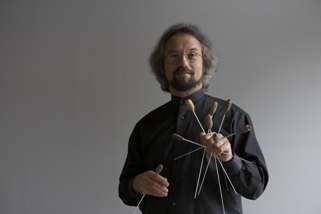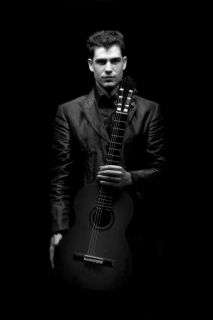|
Back
Pieces of Flair Houston
Jones Hall
04/05/2013 - & April 6, 7, 2013
Joseph Haydn: Symphony No. 37 in C Major
Alberto Ginastera: Variaciones Concertantes
Joaquín Rodrigo: Fantasía para un gentilhombre
Manuel de Falla: Three Dances from El Sombrero de Tres Picos
Pablo Saínz Villegas (guitar)
Houston Symphony, Carlos Kalmar (conductor) 
C. Kalmar (© Michael Jones)
Advertised as "Spanish Masterpieces," the current program by the Houston Symphony only gradually finds its way to that eponymous country. Guest conductor Carlos Kalmar, impressive in his recent recordings with his Oregon Symphony, began the concert with Haydn's seldom-heard Symphony No. 37. It was smart to opt for trumpets and timpani instead of horns for the piece, and indeed the trumpet playing was a highlight of the performance. Kalmar's conducting is physically exaggerated and lacking in economy, but the results he got from the orchestra were taut and precise. His habit of slowing at ends of select phrases put too fine a point on his concept of the movements' structures, suggesting that the audience needed help deciding where the important cadences were.
Ginastera's Variaciones Concertantes is a frustratingly uneven work, but an excellent vehicle for showing off an orchestra's principals. The opening cello and harp duet, perfectly phrased, was intoxicating, although it was a mystery why Kalmar needed to conduct the duet, when players of this level could surely manage to coordinate themselves. As the work proceeds and different soloists and duos are featured, it becomes overindulgent in its virtuosic demands. They pose no challenge for the Houston Symphony principals, from the darting acrobatics of the solo flute to the gloriously intoned horn solo, but the awkward multiple stops in the viola solo and left-hand pizzicato in the violin movement come across as anything but organic, no matter how finely played. The final rondo brings Ginastera more into his nature, importing the rhythmic vitality that makes his ballet Estancia so enjoyable.

P. Saínz Villegas (© Machado)
The second half of the concert was the Spanish half hour. Whether Rodgrigo's twee Fantasía para un gentilhombre is a true "masterpiece" is certainly open to argument, but guitarist Pablo SaÃnz Villegas certainly exaggerated the emotional content of the work with extravagant playing gestures and face-pulling. It came across as melodramatic most of the time, but Villegas' impressive virtuosity was on display during the more technical passages. Kalmar and the orchestra had fun with Rodrigo's quirky scoring, with spiky piccolo playing and zesty trumpet solos adding much-needed invigoration, especially in the final movement. More appropriate for Villegas' theatrics was his superb encore, a thrilling rendition of Roland Dyens' Tange en skai.
Manuel de Falla's underrated Three-Cornered Hat made for a technicolor finale to the evening. The shadows of Rimsky-Korsakov's Capriccio espagnol and, especially, Ravel's Rapsodie espagnole hang heavily over de Falla's ballet-moments of the Spaniard's "Jota" are a near-literal rip-off of Ravel's "Feria"-but there is a quirkiness of phrasing that pervades de Falla's score and gives it its distinctiveness. Horn and cor anglais solos were highlights of the performance, but the finesse of the soloists was matched by the full orchestra, which played with rhythmic precision and capitalized on the many contrasts of timbre in the score. Kalmar negotiated the plethora of gear shifts with ease, and coaxed vibrant playing from the brass, making the final moments of the score viscerally thrilling.
Marcus Karl Maroney
|